Hello and welcome!
As I mentioned last week, over the weekend we held our archdiocesan discernment retreats for men considering a vocation to the priesthood.
So, on Saturday, I joined the group of men who would be candidates for St. John’s Seminary for their retreat at the Betania II Retreat Center in Medway.
Between the retreat at Pope St. John XXIII Seminary, which I spoke of last week, and this retreat, we had over 50 men who came together to consider the possibility of a vocation to the priesthood.
During the weekend, I gave them a series of conferences, and there were a number of panels and group discussions led by our seminarians and vocations team.
We were also blessed with very nice weather for the weekend, which allowed the men to enjoy a soccer match.
I was very impressed by the men who participated, and we are very grateful to all those pastors and campus ministers who referred them to the retreat. Many of those who participated commented on what a wonderful experience it was to be with people who shared their faith, ideals and sense of desire to understand what God is asking of them in their lives.
The retreat culminated with a Mass in the chapel of St. John’s Seminary on Sunday. 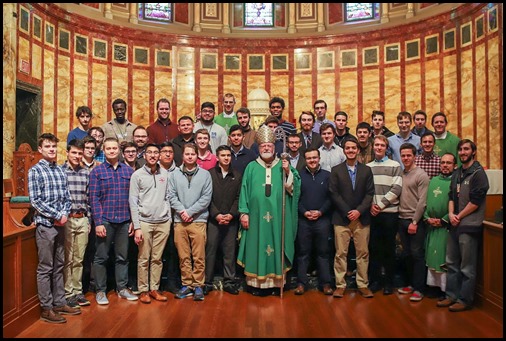
I always tell the men on these retreats that if they haven’t yet told their girlfriends that they are considering the priesthood, we would be happy to blur their faces in the group photo. As you can see, no one took us up on that this time!
Wednesday was, of course, Ash Wednesday, which is such an important date in the Christian calendar.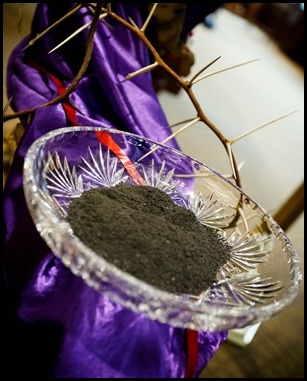
It is an opportunity for us to begin these 40 days of Lent in a way that allows us to deepen our relationship with the Lord, and to be more faithful in our life of discipleship and participation in the community.
On Ash Wednesday, I celebrated two Masses. The first was the noon Mass at Bethany Chapel in the Pastoral Center, which was standing room only.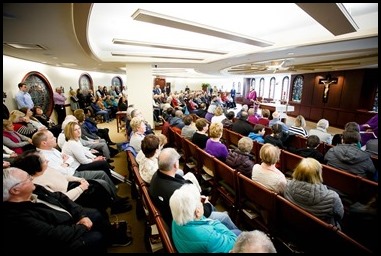
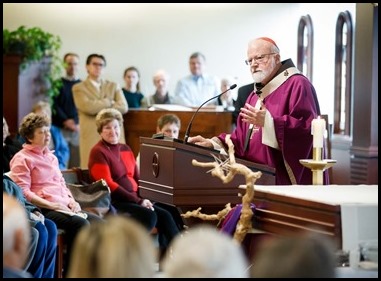
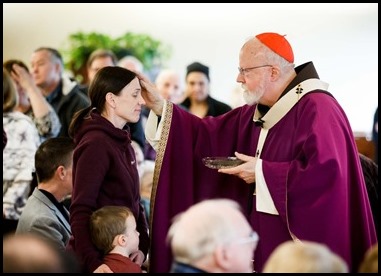

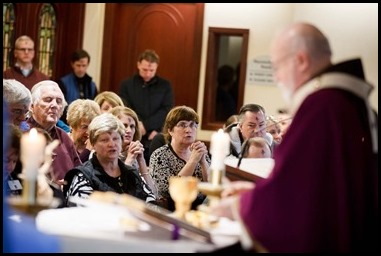
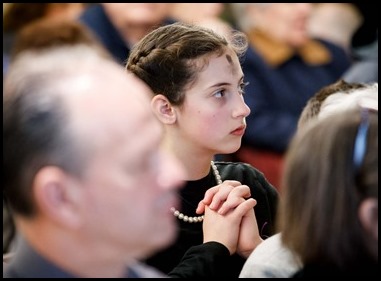
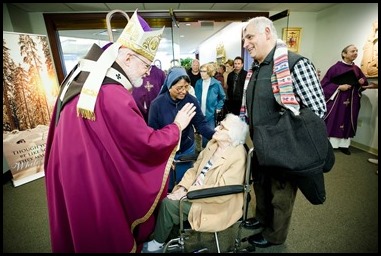
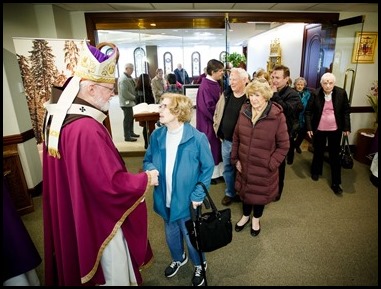
Then, that evening, I had Mass at St. Bridget Parish in South Boston. There the church was full, as well, and it was so encouraging to see so many young people join us. 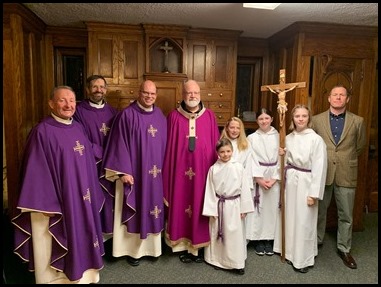
It is always very edifying to see how many Catholics respond to the practice of receiving the ashes.
I’d Like to share my Ash Wednesday homily with you here:
Lent is my favorite four-letter word. Actually, it is an old Anglo-Saxon word that means ‘springtime.’ For us, Lent is a time of rebirth and renewal, a time of greater spiritual light and warmth that expels the winter of self-indulgence and mediocrity. Lent is a baptismal retreat, accompanying Jesus on the 40 days in the desert so that we can be better prepared to live a life of discipleship and embrace the mission of building a civilization of love in a world fractured by hate and indifference.
Every Ash Wednesday, ironically enough, we begin by listening to Jesus’s warning: “Beware of practicing your piety before others in order to be seen by them; for then you will have no reward from your Father in heaven.”
Jesus is talking to us about the what: the acts of penance, the prayer, fasting, and almsgiving, which are important, but more important is the how and the why. The Pharisees were great at public prayer, fasting and almsgiving, but it was more a case of spiritual one-upmanship than an act of penance.
Jesus is urging us to look at our motives and to avoid the temptation to do religious acts in order to increase our prestige with people. This penchant to do things with the hope that they will promote us in the eyes of others is a built-in human tendency. We are always looking for a little more social capital to assure us of our worth. We spruce our bodies, so people will consider us handsome or beautiful; we display our knowledge to be known as competent and intelligent; we advertise our wealth and position to be known as important and powerful. Social climbing is not the flaw of the few; most people have a little Mrs. Hyacinth Bucket in them, because keeping up appearances is so important as people struggle to find a place in a hierarchical and competitive society.
However, when this pervasive inclination invades religious acts, it vitiates the acts themselves, undercutting their purpose. Religious acts are meant to bring God and creature into a closer union. This closer union is characterized by the human being receiving love and life from the transcendent source of love and life, the heavenly father, and then extending that love and life to others. So when the inner stance is geared first and foremost toward social acknowledgment, they’re looking in the wrong direction. In other words, outer religious acts of piety have to be done with the proper inner attitude or they do not adhere to their primary purpose, and our only real award will be the passing notice of the people around us rather than growing closer to our God.
On the other hand, sometimes performing good works in a public way can be an act of courage, a witnessing of our faith in a society that only embraces secular and materialistic values. I always like to say that being a Catholic in Boston is a contact sport, but on Ash Wednesday, the ashes on our forehead are part of our team’s uniform.
The external Lenten practices are supposed to express an inner desire for deeper conversion, turning our back on selfishness and sin in drawing closer to God, embracing the teachings of the Gospel and trying to make our life a reflection of those teachings.
Sometimes Lent is reduced to 40 days of healthier living: giving up cigarettes again, going on that low-carb diet or stepping onto the treadmill. Don’t get me wrong; these acts of discipline can be spiritually beneficial if they can help us overcome self-indulgence and unhealthy behavior. But the success of our Lent cannot be measured by the number of pounds we lose or how many steps we take each day measured on our Fitbits.
If anything, fasting should be coupled with almsgiving. If we spend less money on our creature comforts, we can use those resources to bring relief to the poor and the suffering. Lent is a good time to reflect on the Gospel parable of the Last Judgment where Jesus says: I was hungry, and you gave me to eat. Mother Teresa reminds us that in the poor, the outcast, the homeless, we can see Christ in a distressing disguise. Part of our Lent needs to be about discovering Christ in the poor and the hungry.
Lent is a good time to take stock of our prayer life, making sure that we have time and space for God each day in our lives. We all need a simple rule of life, a plan of how we will rob a few minutes of our busy day and dedicate them to prayer and reflection on the Word of God.
Lent is also about reconciliation. If you are suffering from Irish Alzheimer’s — which means forgetting everything but the grudges — Lent is a time to bury the hatchet, to look for paths of reconciliation and forgiveness. It’s also time to receive the sacrament of confession as an encounter with the merciful Lord who comes as our friend to assure us of his forgiveness and to teach us how to forgive others.
My Christmas homily was about homelessness, both the homelessness of those who have no place to lay their head as well as the spiritually homeless who are cut off from their spiritual roots. Lent begins with a clarion call of the prophet Joel: “Even now, says the Lord, return to me with your whole heart, with fasting, and weeping, and mourning; rend your hearts, not your garments and return to the Lord your God. For gracious and merciful is he, slow to anger, rich in kindness … Blow the trumpet in Zion! Proclaim a fast, call an assembly, gather the people.” If we are homeless, Lent is an invitation to come home. When the Prodigal Son returned home, his father rushed out to meet him, kissed him, put a ring on his finger and sandals on his feet, and celebrated his return with the banquet. Our God rejoices when he can forgive us, embrace us, welcome us home.
The ashes also betoken the fragility of life. We are pilgrims here, and for some, the journey is shorter than others. The ashes are a reminder that we are dust and we shall return to dust, but we receive the ashes in the sign of the cross because the dust has been redeemed by the loving sacrifice of Jesus Christ our Savior. Ash Wednesday is not meant to be a morbid reflection on death, but a serious reminder that life is always short, and we must be good stewards of the time, talent, and treasure that we have received. It is also a reminder that we must take care of each other and use our time well. Time is used well when it is filled with love and service and joy. Turning our hearts and minds to God puts us on that path, and that’s what Lent is about.
Thursday morning, I was pleased to meet with the new superior of the Missionaries of Charity in Boston, Sister Rose Therese. She is originally from India but was most recently working in Asbury Park, New Jersey before coming to Boston.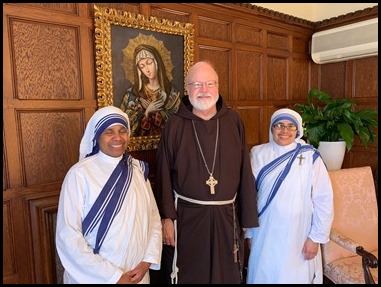
She told me how happy she was to be here and how pleased she was to see the wonderful ministry of the sisters in Boston, working in outreach to homeless women and caring for the children and families of the neighborhood.
I shared with her the story of the time that I first met Mother Teresa, back when I was teaching at the Catholic University of America in 1971.
Mother Teresa was receiving an honorary degree from CUA, but at the time no one really knew anything about her, and only a handful of people were present.
Eileen Egan, the head of Catholic Relief Services, introduced her and spoke about her work taking care of the dying – picking people up in the train stations and streets of Calcutta and bringing them to an abandoned Hindu temple where they could die with dignity, surrounded by love.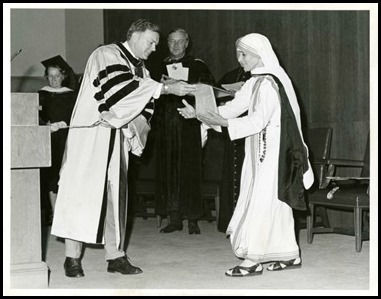
Afterwards, I went to Cardinal O’Boyle and said: “Your Eminence, this was a terrible blunder.” He was a bit taken aback and asked, “What do you mean, Brother?” And I answered, “This should have been at the Shrine of the Immaculate Conception, and you should have had all the students and faculty of Catholic University there to hear this woman!”
Of course, soon, Malcolm Muggeridge’s documentary and book, “Something Beautiful for God,” would bring Mother Teresa to the consciousness of the world — but I was very fortunate to have had a preview during my days teaching at Catholic University!
Later that morning, we had a breakfast reception for Sister Norma Pimentel, the executive director of Catholic Charities of the Rio Grande Valley in the Diocese of Brownsville, Texas, who is well known for her work aiding refugees on the U.S.-Mexico border.
She will be receiving our Justice and Compassion Award at Catholic Charities’ Spring Celebration in May but was in town this week to take part in an event sponsored by Catholic Charities at which she discussed immigration and the plight of refugees at the border.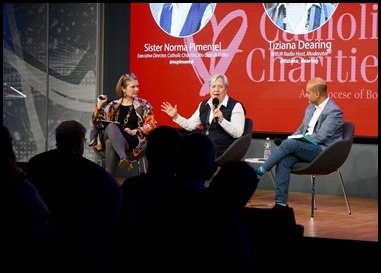
So, we were very happy to have this breakfast meeting at the cathedral with Kevin MacKenzie, our Board Chair and Interim President of Catholic Charities, along with many other friends and supporters of Catholic Charities.
I was very pleased to have a chance to finally meet Sister Norma in person. I shared with her that, for 20 years, I had a similar ministry, working at the Centro Católico Hispano, where most of our ministry was to refugees and undocumented immigrants fleeing the wars in Central America. So, I told her I have a very strong sense of identification with the work that she is doing.
Until next week,
Cardinal Seán
